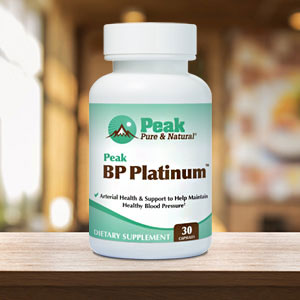Get Easy Health Digest™ in your inbox and don’t miss a thing when you subscribe today. Plus, get the free bonus report, Mother Nature’s Tips, Tricks and Remedies for Cholesterol, Blood Pressure & Blood Sugar as my way of saying welcome to the community!
The blood pressure myth that could mess with your heart

When you’re sitting on an exam table in your doctor’s office with a blood pressure cuff crushing your arm, your doc always tells you two numbers: systolic blood pressure and diastolic blood pressure.
A lot of us (myself included) don’t have a great grasp of what these numbers mean when our doctor rattles them off to us. So, let me explain…
The top number (systolic blood pressure) is how much pressure the heart uses to pump blood into your arteries. The bottom number (diastolic pressure) is how much pressure there is in your arteries in between heartbeats.
For a long time, one of those numbers stole the spotlight: systolic.
That’s because decades of research showed that high systolic blood pressure was more likely to cause serious cardiovascular problems like heart attacks and strokes. As a result, cardiology guidelines focus way more on the upper number. And there are even some experts who think diastolic blood pressure can basically be ignored.
So, at some point in your life, you may have been told that diastolic blood pressure doesn’t really matter. It’s the systolic reading you really need to worry about.
But a new study shows this is bad advice. High diastolic blood pressure comes with serious risks too…
Why diastolic blood pressure really does matter
A recent study from the healthcare company Kaiser Permanente found that systolic and diastolic blood pressure both make a difference in your stroke and heart attack risk.
The study was a big one… it included health information from more than 1.3 million people and more than 3.6 million blood pressure readings from these people. Here’s what researchers discovered through this data…
Diastolic and systolic blood pressure both impact your risk of heart attack and strokes independent from one another. That means, if your diastolic blood pressure is high, you have a higher risk of heart attack and stroke no matter what your systolic blood pressure is.
Related: Why blood pressure testing is mostly wrong
Now, systolic blood pressure did have a greater impact on stroke and heart attack risk than diastolic. But both had a significant impact on these risks, so ignoring one or the other isn’t a wise idea.
“This research brings a large amount of data to bear on a basic question, and it gives such a clear answer,” said lead author Alexander C. Flint, MD, Kaiser Permanente stroke specialist and adjunct researcher with the Division of Research. “Every way you slice the data, the systolic and diastolic pressures are both important.”
How to tackle high blood pressure
Remember, the American College of Cardiology and the American Heart Association set new blood pressure guidelines in 2017. They lowered the threshold for what’s considered “high.” Previously, 140/90 mm Hg was the cut off for high blood pressure, now it’s 130/80 mm Hg. So, if your blood pressure is suddenly “high” at your next doctor visit, that could be why.
There’s still controversy about whether this change will help people. But for now… them’s the rules.
Related: 19 natural alternatives for healthy blood pressure
If you do find out at your next doctor’s visit that your blood pressure is high, there are a few simple approaches you can take to lower it. You can:
- Exercise. It only takes 30 to 60 minutes of exercise five days a week to lower blood pressure by 4 to 9 mmHg for most people.
- Lose weight. If you’re overweight, losing weight can lower your blood pressure significantly.
- Relax. Stress increases blood pressure. Luckily, relaxing has the opposite effect. You can use yoga, meditation or biofeedback to trigger the relaxation response in your body and lower your blood pressure.
- Sleep enough. Not getting enough sleep increases your odds of developing high blood pressure. So, getting seven to eight hours of sleep per night is a simple way to improve your blood pressure.
- Eat a blood pressure-friendly diet. Eating more whole grains, fruits and vegetables can improve your blood pressure. Avoiding processed foods that are high in sodium is a good idea too. You’ll also want to cut out (or limit) drinks that increase blood pressure like those containing caffeine and alcohol.
Editor’s note: Have you heard of EDTA chelation therapy? It was developed originally to remove lead and other contaminants, including heavy metals, from the body. Its uses now run the gamut from varicose veins to circulation. Click here to discover Chelation: Natural Miracle for Protecting Your Heart and Enhancing Your Health!
Sources:
- Effect of Systolic and Diastolic Blood Pressure on Cardiovascular Outcomes — New England Journal of Medicine
- New study finds both components of blood pressure predict heart attack, stroke risk — MedicalXpress
- Both blood pressure numbers may predict heart disease — Medical News Today
- FAQs — Blood Pressure UK
- Pulse pressure: An indicator of heart health? — Mayo Clinic
- 10 ways to control high blood pressure without medication — Mayo Clinic













